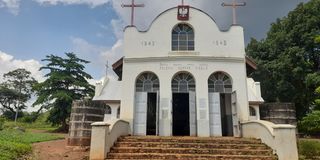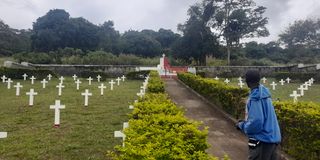Prime
Preserving Uganda’s long history of welcoming refugees

This church was built by the Polish refugees in Nyabyeya Parish, Masindi District. PHOTO/GILBERT MWIJUKYE
What you need to know:
Between 1942 and 1944, Uganda hosted close to 7,000 Polish refugees, mainly women and children in Nyabyeya in Nyabyeya parish, Budongo sub-county in Masindi District and Koja (Mpunge) in Mukono District
Nestled on the edges of the lush Budongo Forest Reserve in western Uganda is an 80-year old catholic church built by Polish exiles who fled Europe in 1942 during World War II and made this place their home for six years.
Within the church compound is a cemetery, the final resting place for up to 44 Polish refugees who died during their stay here due to tropical diseases.
Gazzeted by the Ugandan government five years ago as an important historic monument, this site is representative of Uganda’s long history of indiscriminately welcoming people fleeing war in their home countries.
Uganda is currently ranked among the top five countries in the world that are known to host refugees – with the current number of refugees in the country estimated to be 1.5 million and spread across 11 settlements in different parts of the country.
Even though the majority of these settlements host refugees from neighbouring countries such as Rwanda, South Sudan, Somalia, DR Congo and Burundi, Uganda has been known to welcome refugees from as far as Asia and Europe – and as recently as 2021 the country was due to host hundreds of refugees from Afghanistan.
Important piece of history
But what makes the Nyabyeya Polish cemetery site an important landmark is that it is one of the first two refugee settlements in the country – along with the Mpunge settlement in Mukono, about 80 kilometres east of Kampala, which also hosted Polish refugees fleeing World War II. A picturesque peninsula that stretches into Lake Victoria, Mpunge played host to about 3,500 Polish refugees while Nyabyeya hosted an estimated 3,000 of them.
During those dark years as war raged across Europe, about one million Polish nationals were condemned to life in exile in different parts of the world when Adolph Hitler’s Germany and Joseph Stalin’s USSR annexed large parts of their country.
Uganda played host to two of the 22 Polish refugee’s settlements across British colonies in Africa – with Kenya, Tanzania, South Africa, Zimbabwe and Zambia being the other countries where the Polish refugees were settled.
Today, these sites have become popular tourist attractions, attracting both locals and Polish tourists with an interest in this bit of history.
“The Ugandan government is currently working with the Polish government to preserve these sites. These sites are even more important to the Poles because the Polish refugees enjoyed Uganda’s remarkable hospitality. I fact, it is this hospitality that inspired the Polish government to become one of the funders of some refugee settlements in Uganda,” Rose Mwanja, the commissioner of Uganda Museums, told Daily Monitor.
In 2018, the Polish embassy in Kenya organised an exhibition at the Uganda Museum in Kampala showcasing the life and times of the Polish refugees in Uganda. The event was attended by several descendants of the Polish refugees, according to Ms Mwanja.
“During that time the Polish embassy also renovated the burial site at Mpunge, and there are plans to renovate that of Nyabyeya,” Mwanja say.
As appreciation for the local community’s hospitality during the dark days of World War II, in 2017 the Polish government built a primary school near the former refugee settlement and also offered financial assistance to the Mpunge Health Centre II. The school is currently run by the Catholic Church while the hospital is state-run.
Social life
During their stay in Uganda, the Polish refugees were perceived as social by most Ugandans because they were not racist, according to Samuel Juuko, a resident of Mpunge whose parents interacted with the Poles.
“Many of our parents used to freely interact with the Poles and many of them even learnt how to speak Polish,” said 47-year-old Juuko.
However, Juuko said that there were no intermarriages between the Poles and Ugandans, which perhaps partly explains why there are no known descendants of these refugees living in Uganda today.
“Some old people here say that they had romantic relationships with some Poles but they (the Poles) never wanted to have children with Africans. Some say Polish women would rather abort than have children with Ugandans,” he said.

The grave site in Mpunge where 96 Polish refugees were buried. PHOTO/GILBERT MWIJUKYE
From war to tropical diseases
Mostly comprising the elderly, women and children, the Polish refugees arrived in Mombasa by boat and continued their journey to Uganda by rail.
However, even though Uganda proved to be a more peaceful place compared to their home that had been turned into a war zone, the environment of Nyabyeya proved to be less hospitable to the refugees, especially the elderly, as many of them who succumbed to tropical diseases such as malaria.
And even as picturesque and revitalising as the Mpunge peninsula was, the nearby papyrus swamps and dense forests made it difficult for the refugees to survive mosquitoes and tsetse fly bites.
Tropical diseases at Mpunge were even more catastrophic than in Nyabyeya, especially considering that up to 96 Poles died from the settlement just within the six years they spent there.
End of the Ugandan Sojourn
When World War II finally ended, the Poles in Uganda left for countries such as Canada, Australia and the UK, while just a few of them are said to have returned to their homeland. None of them remained in Uganda.
For those who were buried in Nyabyeya and Mpunge, their descendants regularly visit the grave sites that were left behind to pay their respects, according to Nelson Abili, the principal conservator at the Uganda Museums.
In Nyabyeya, the church they left behind is still functional and operates under the Catholic Church while some of the structures they left behind have since been occupied by the Nyabyeya Forestry College, Uganda’s only forestry educational institution.
THE NUMBERS
Uganda hosted close to 7,000 Polish refugees, mainly women and children between l942 and 1944. The British protectorate government settled the Polish refugees in Nyabyeya in Nyabyeya parish Budongo sub-county in Masindi District and Koja (Mpunge) in Mukono District.
The refugees built the Our Lady Queen of Poland Catholic Church that has since been renamed St. Mary Nyabyeya Catholic Church and sits a few meters from Nyabyeya Forestry College.
Built between 1943 and 1945 by the Polish refugees, the church still serves the local community. Polish students renovated the church in 2010.





